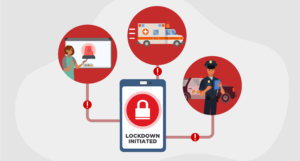Americas Safe Schools Week is October 17-23. To honor America’s Safe Schools Week all month, Raptor Technologies is sharing some of the best practices we have compiled from our 32,000 K-12 customers and nearly 20 years of experience as a school safety partner. This series of 4 articles highlights drills, emergency response, parent-student reunification, and more.
Emergency situations when any decision could be the difference between life and death can be stressful and traumatic for anyone involved. The more your school community is trained to respond, the less chaotic, and therefore the more successful, your emergency response will be.
Your staff and students safety hinges on how well you conduct and learn from your drills. Conducting drills helps your teachers, students, and staff be prepared so they can confidently respond and keep everyone safe if an actual crisis occurs. Drills:
- familiarize your school community with your emergency operations plan (EOP) and their individual responsibilities, roles, and actions
- reveal areas of weakness in your response
- create muscle memory and increase response efficiency
The Marjory Stoneman Douglas High School Public Safety Act (MSDHSPSA) requires all Florida K-12 public schools to have policies and procedures for emergency drills like fires, active shooters, and bomb threats. Below are some of the best practices for managing and conducting these various drills.
Planning & Scheduling Ensures You Get the Most from Each Drill
Drills require a lot of upfront planning, like deciding what drill to perform and when especially now during COVID-19 to get the best participation possible. When thinking about your drills, its important to consider your states requirements and the type of drill, location, duration, time, and frequency. Because emergencies can happen at any time while some students are at lunch or on the soccer field, for examples drills should be run at various times throughout the day and age-appropriate strategies that go beyond the typical procedure should be taught. For instance, if a student is in the hallway or bathroom when an active threat arises, they need to know what to do and where to go to be safe. Your emergency operations plan and drills should consider every scenario a student or staff member may be in when a crisis strikes.
Other considerations include your school populations developmental maturity and the stress that certain drills can cause. The Florida Office of Safe Schools mandates active shooter or hostage situation drills are conducted with developmentally appropriate procedures. Further, the Partner Alliance for Safer Schools (PASS) recommends conducting drills in an educational way without violent simulations to avoid traumatizing participants. PASS also recommends announcing upcoming drills to staff, students, and parents so no one is caught off guard.
Consistent Practice Leads to Confident Response
Your school community should treat every drill whether its for a hypothetical fire or a violent intruder as if its a real emergency. Taking shortcuts, allowing staff or students to sit out and not participate, or not taking the drill seriously will lead to your school not being able to respond well in an actual situation. Every drill should also strictly follow your emergency operations plan, so your school community gains more familiarity with the plan and becomes more confident with each drill.
Let’s take a moment to focus on confidence. Being confident in your response whether you are a teacher, staff member, or student is critical. This is especially important, though, for teachers and staff, as research shows that their demeanor directly impacts students physical and psychological safety. If a teacher lacks confidence, it makes it nearly impossible for them to stay calm or be viewed as a trusted leader. The more a teacher or staff member remains calm, the more the students stay calm and the more likely they will follow your emergency operations plan. Conducting drills, therefore, is not only important to train your school community on what to do, but to also build their confidence so everyone can calmly and courageously follow the procedures throughout the crisis.
Assessing Your Drills Leads to Improved Performance
It can be easy to fall into the routine of each drill and continue to use the same emergency response plans every year, but that is dangerous. Drills are conducted to test the procedures and policies your school has in place. After each drill, staff and students should be encouraged to provide feedback and your safety team should immediately debrief. To assess your drills well, schools need a method of tracking drill data and creating comprehensive reports.
Regarding reporting on drills, Michael Edwards, Director of Duval County Schools Police Department, states, Its one thing to say you conducted a drill; its another to prove it with documentation and to have that documentation at your fingertips. Assessing your drills and looking at the performance data within those reports like how efficient the drill was gives you the opportunity to see what is working and what areas you need to improve to better protect your students and staff. The reports also enable you to prove your compliance with state and district drill requirements.
Incorporating these best practices can help strengthen your drill program and build your school communities confidence so that they can remain calm and confident in an actual crisis.
The MSDHSPSA also requires districts review their policies and procedures for compliance with state laws and regulations, including Alyssas Law. Keep a look out for next weeks newsletter that highlights Alyssas Law and best practice for emergency notification and response.



